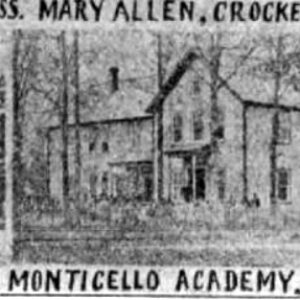calsfoundation@cals.org
Monticello Academy
Monticello Academy in Drew County was under the sponsorship of the Board of Missions for Freedmen of the Presbyterian Church in the U.S.A. (PCUSA), or the “Northern” Presbyterian Church, which first began opening schools for freed slaves in the South in the 1860s. However, it was not until the 1880s, when a new presbytery had been established in the state and numbers of African Americans from the eastern states were resettling there, that the board felt confident enough to begin its work in Arkansas.
The academy was started in 1891 by the Reverend C. S. Mebane, who had come to Monticello (Drew County) in 1888 as the pastor of Second Presbyterian Church there. He was closely aided in his work by Dr. Mary Emilie Holmes, the daughter of Dr. Mead Holmes, a member of the Board of Missions. Mary Holmes was a remarkable woman of her time, as she was the first woman to earn a doctorate in the study of earth sciences. While completing her doctorate at the University of Michigan, she also taught natural sciences at Rockford Seminary. She soon, however, decided to begin work with the Woman’s Home Missionary Society. She began volunteering with the board in 1886 and traveled widely to garner support for the education of African Americans. Around this same time (1887), she also published two collaborative novels with other women, one of which was titled Aida Rocksbege and the White Stone: Today’s Problem, a Presbyterial Romance. This short novel was apparently based on her own personal experiences in missionary work. Soon after she began her work with Rev. Mebane, the name of his church was changed to Holmes Chapel in her honor.
The board’s report for 1891 indicates that the new academy was opened at a cost of around $2,000, money provided almost entirely by the women of Illinois. There were sixty-two students enrolled at the time, and Sallie Means was their teacher. By 1893, there were 152 students and two teachers; a year later, the enrollment had swelled to 210, and there were five teachers, including Mebane. In 1899, there were 200 students, thirty-four of whom were boarders. The school session ran for eight months and included primary, preparatory, teaching, and higher courses. Boarding students were taught domestic work in addition to academics.
The relationship between Holmes and Mebane eventually caused problems for the school, as the racial climate in Monticello was not one that tolerated such a close collaboration between a Black pastor and a white woman. Mebane and Holmes went about their work regardless, and Mebane began to receive death threats. By 1904, money had been raised for an additional structure at the school, but the racial tension surrounding the academy forced the board to close it temporarily. Mebane left Monticello for Hot Springs (Garland County), where he became head of the Hot Springs Normal and Industrial Institute, also known locally as Mebane Academy. Holmes went on to found the Mary Holmes Seminary in West Point, Mississippi.
The Monticello Academy reopened in the fall of 1905 under the supervision of the Reverend O. C. Wallace, whom the board hoped would be able to ease the tension in Monticello. The school was immediately filled even though the boarding department had been discontinued because of the board’s inability to construct a new dormitory. In a further attempt to reduce racial tension in 1906, the board decided to move the school site to a more suburban location. By 1909, the old building had been sold, and the campus moved to a larger plot, which would also allow increased opportunities for industrial training. In 1911, the academy had ninety students who were being taught by Rev. Wallace, his wife, and one other teacher.
A report published by the U.S. Office of Education in 1917 indicates that the academy had ninety-nine students and four teachers. It was located on two acres of land on the edge of town, and the plant included a small frame house and a large frame building used as a dormitory. The report recommended that the school remain open because with some reorganization, it could be “developed to serve useful ends in its community.”
Wallace resigned in 1920 and was replaced by the Reverend R. H. Carroll. He and his wife and two other teachers took over supervision of the seventy students. By 1926, the academy was offering three grades of elementary education and four years of high school. This was by far the best education available for Black students in that section of Arkansas.
The school was still thriving under Rev. Carroll in 1931, but attitudes were beginning to change in the PCUSA. The church’s General Assembly decided to discontinue support of all elementary and high schools for Black students, including boarding schools that drew most of their boarders from the local community. On June 1, 1933, to the dismay of the African-American community, many Presbyterian schools across the South, including the Monticello Academy, were closed, and Black students were left at the mercy of the mostly inferior public schools.
For additional information:
Droessler, William. “Charles Mebane, Mary Holmes and the Monticello Academy: A Black Mission School in the South.” Drew County Historical Journal 7 (1992): 4–20.
Jones, Thomas Jesse. Negro Education: A Study of the Private and Higher Schools for Colored People in the United States. Vol. 2. Washington DC: Government Printing Office, 1917.
Parker, Inez Moore. The Rise and Decline of the Program of Education for the Black Presbyterians of the United Presbyterian Church U.S.A., 1865–1970. San Antonio: Trinity University Press, 1977.
Richings, G. F. Evidences of Progress among Colored People. Philadelphia: George S. Ferguson Company, 1903.
Nancy Snell Griffith
Presbyterian College
 Monticello Academy
Monticello Academy  Monticello Academy Controversy
Monticello Academy Controversy 




Comments
No comments on this entry yet.